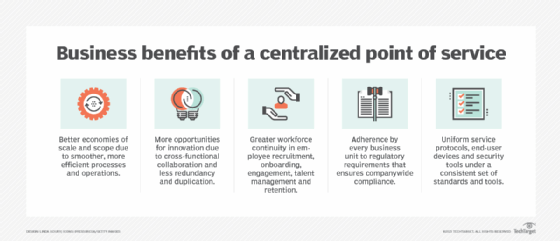
alotofpeople - stock.adobe.com
Building a shared services organization structure
Amid the shifting economic climate and new reality of hybrid workforces, there's no better time for companies to consolidate business functions and centralize support services.
Several factors are contributing to the trend toward centralizing business functions and sharing services, including today's economic climate, the new reality of hybrid and remote workforces, and easier provisioning of new services in cloud environments. IT departments are developing strategies to integrate all business functions into a centralized point of service to streamline operations, reduce redundancies and duplication, and lower costs.
"It is very common for large organizations to centralize their IT services, especially for application support, cybersecurity and infrastructure services such as networking, compute and edge, help desk, and service management," said Venky Jayaraman, U.S. cloud and digital strategy practice leader at PwC.
By centralizing business functions and sharing services, some companies have realized as much as 20% to 40% in cost savings, according to Jayaraman. Centralization enables companies to standardize on common architectures and platforms. With a less fragmented technology landscape, businesses can more readily automate processes, scale, and consolidate the technical expertise required to support their infrastructure.
If each business unit, for example, had a dedicated networking team following its own standards and processes, then it could only monitor and patch its own routers. When companies transition to a single, centralized networking team that operates a single technology, a smaller group can monitor the entire network and deploy updates and patches centrally using automation.
Centralization of business functions is a multistep process
Centralizing services isn't as simple as flipping a switch. Integrating business functions into a shared services organization (SSO) structure is a multistep process increasing in complexity with each move up the tech stack, Jayaraman explained.
- The process often starts with centralizing infrastructure, rationalizing data centers and ensuring common network and security tools. This step is relatively straightforward and can be executed by IT without significantly impacting business operations.
- The focus then turns to centralizing application support and development. This step can delay response times for business units that typically deal with local groups, but the result is more stable systems and lower overall costs.
- The more significant challenge is full integration and centralization of services and applications among business units. The IT department works with business teams to rationalize the application footprint, focusing on migrating business processes and users to a common platform. "This involves significant change management and training for the business units," Jayaraman noted.

Transitioning to an SSO structure
Five basic questions need to be asked when planning to centralize business functions and share services companywide, according to Jimit Arora, partner at management consultancy Everest Group.
- Why are we doing this?
- What is in scope versus not centralizing?
- Where should we locate these services?
- Who should deliver these services?
- How should we manage these services?
Many organizations unfortunately leapfrog the why and go directly to the what, where and who without clarifying the problem they're trying to solve using a shared services model.
"There [are] a lot of best practice learnings possible as companies seek to understand the what, where and who," Arora explained. "However, answering the why is very contextual to the organization. Communicating and aligning on the why becomes critical to the success of a shared services journey."
Asking why can help decide what functions to bring into the shared services infrastructure. Teams can then determine where to locate services and who should deliver them. Companies must also consider whether they will own the IT employee base or rely on outsourcing or contractors to achieve their objectives. The final step is how to achieve the ongoing management and optimization of the model to ensure goals are being met.
Top benefits of centralization and shared services
A centralized SSO structure can reduce waste and increase purchasing power. And since implementation of a centralized process involves the entire company, every department shares in the successes and failures, resulting in a faster and sharper learning curve. Most companies see the following SSO benefits with a shared services model, according to Arora:
Improved economies of scale and scope. Consolidating business functions helps ensure there's no duplication of similar resources, enabling a more efficient and cost-effective IT estate.
Innovation without duplication. It's common for business units to work in silos when innovating products, processes and systems. The result is separate learning curves because each unit decides which DevOps technology, suppliers and metrics to use. A centralized approach enforced by a standard playbook can improve collaboration and accelerate outcomes across all business units.
Workforce continuity and engagement. The Great Resignation, spawned by the COVID-19 pandemic, has significantly impacted the recruiting, hiring and retention of skilled workers. Consolidation and centralization of business services help improve employee engagement and talent management initiatives, build a more connected career path for employees and retain them in a competitive job market.
Companywide regulatory compliance. In regulated industries, following a standardized playbook is essential. Centralization helps ensure that every business unit adheres to various regulatory requirements.
Cyber resilience. Hybrid and remote work environments have increased the threat surface for many organizations, which is exacerbated when each department depends on different service protocols, end-user devices and security tools. Centralizing functions and sharing services yields a consistent set of standards and tools that can help minimize security issues.
With the rewards come potential risks
Enterprises can encounter several challenges as they explore a shared services organization structure.
- Business units might feel like they're losing control and responsiveness from a centralized IT team, PwC's Jayaraman said. Competing IT goals, for example, might be prioritized, and IT's response to a given request could be slowed because the centralized IT team might decide to optimize for average rather than peak workloads. It's helpful to form a strong partnership between IT and business units, Jayaraman suggested. In addition, establish clear service level agreements that accurately reflect risk and priorities so IT can separate mission-critical from lower-priority requests.
- A shared services approach can run the risk of becoming overly complex, Arora warned. A simple service request through Teams, for example, might now require adherence to a more complex service management system. The best shared services models, Arora said, often combine centralized architectures with federated architectures to enable interoperability and information sharing among lines of business.
- Tech stacks consolidating under an SSO structure could demotivate the workforce. "If the estate shrinks, then the shared services can feel like a graveyard of ambition," Arora said. "Consequently, the leadership needs to ensure there is a growth ramp to keep the talent motivated."







